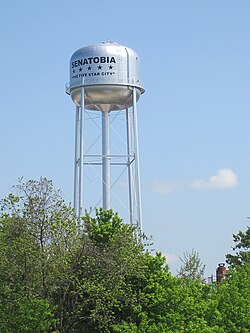Senatobia, Mississippi | |
|---|---|
 | |
| Motto: The Five Star City | |
 Location of Senatobia, Mississippi | |
| Coordinates: 34°36′59″N89°59′10″W / 34.61639°N 89.98611°W | |
| Country | United States |
| State | Mississippi |
| County | Tate |
| Chartered | 1860 |
| Government | |
| • Mayor | Greg Graves [1] |
| Area | |
• Total | 15.64 sq mi (40.51 km2) |
| • Land | 15.56 sq mi (40.30 km2) |
| • Water | 0.081 sq mi (0.21 km2) |
| Elevation | 279 ft (85 m) |
| Population (2020) | |
• Total | 8,354 |
| • Density | 537.0/sq mi (207.32/km2) |
| Time zone | UTC-6 (Central (CST)) |
| • Summer (DST) | UTC-5 (CDT) |
| ZIP code | 38668 |
| Area code | 662 |
| FIPS code | 28-66440 |
| GNIS feature ID | 2405443 [3] |
| Highways | |
| Website | http://www.cityofsenatobia.com |
Senatobia is a city in and the county seat of Tate County, Mississippi, United States, [4] and is the 16th largest municipality in the Memphis Metropolitan Area. The population was 8,165 at the 2010 census. Senatobia is home to Northwest Mississippi Community College, a state community college providing two-year academic and technical degree programs. Also located in Senatobia is the Baddour Center, a residential care facility for intellectually disabled adults.









